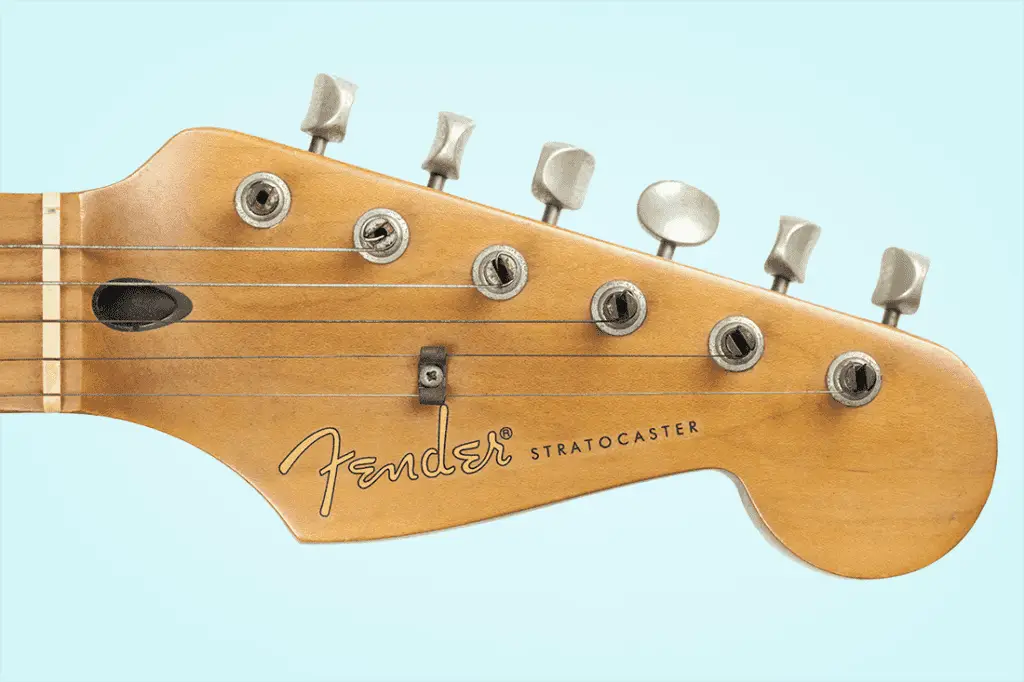
Putting stickers on a guitar is an easy and cheap way of making it look cool and unique. It will also make it appear more rugged and beat-up, which goes well with the style of many musical genres, but is it safe? Could you harm your guitar by doing so?
It is generally safe to put stickers on a guitar, whether it is classical, acoustic, or electric. However, there is a right and a wrong way to do it. Decorating your guitar can be fun but can also affect the guitar’s playability, sound, and appearance permanently.
Putting a few stickers on your guitar may seem harmless, but even that can damage your guitar. Make sure to read the full article to prevent unnecessary damage to your guitar.
Is it safe to put stickers on a guitar?
Improper use of stickers can lead to loss of resonance by attenuating the vibrance of soundboards in classical and acoustic guitars. It can also interrupt the fluency in your playing if positioned randomly, or result in an uneven aging process of your guitar’s finish.
Putting stickers without damaging the guitar

If you decide to decorate your guitar with stickers, here’s how you should do it:
Classical and acoustic guitars: Try to avoid putting stickers on the guitar’s soundboard, as each sticker will act as a little damper. The soundboard (located at the front of the guitar) is the most prominent part of the guitar’s soundbox. It tremors while we play and amplifies the sound coming out from the strings. It also has a tremendous effect on the sound characteristics of our guitar.
Try placing stickers on the sides and backside of the guitar to minimize any interference to your guitar sound.
Solid-body electric guitars: With electric guitars, it is a different story as the sound-making process is entirely different. The amplification in electric guitars is done by the guitar pickups. When the magnetic field above them changes (through string movement), they produce an electric current. This process is entirely electronic, so putting stickers on the guitar’s body wouldn’t affect it.
You can cover your (electric) guitar completely with stickers, and it would sound exactly the same as it did before. You can even cover the pickups themselves with stickers without harming the functionality of your guitar. Just make sure you don’t position them in a place where they will interrupt your hand or rub against your skin while playing.
Do stickers affect guitar sound?

Many guitarists would argue that the minor differences in sound between a guitar with stickers to a guitar without stickers are hardly noticeable, and therefore, you should decorate it however you want. I beg to differ, especially when it comes to acoustic and classical guitars.
Every component added to the guitar changes its behavior in some way. Of course, some components are more dominant than others, but they all play a part in compiling our guitar sound.
Stickers can work as dampers if they are positioned excessively on soundboards, just like the little pieces of tape used by drummers to dampen their snares and toms. It may sound insignificant to some of us, but to me, even the tiniest change in resonance matters, even if I cannot spot it with my own ears.
Things you may want to know before covering your guitar with stickers
Pros:
- Hide dents – besides being decorative, a sticker can also hide ugly hits and scratches on your guitar.
- Customize your guitar – Decorating a guitar with stickers is a cheap, fast, and easy way of making a guitar unique,
- Safer against theft – A guitar with stickers will be less attractive in the eyes of a thief who knows nothing about guitars.
- Note map guitar stickers – Fretboard map stickers can help beginners learn the guitar fretboard by heart.
Cons:
- Even if only by little, stickers can affect a guitar’s sound, especially with acoustic and classical guitars.
- Stickers can lead to differences in the aging process, leaving silhouette marks after removal.
How to remove stickers from a guitar without damaging it
When removing old stickers from a guitar (electric, classical, or acoustic), the finish could easily get hurt, so make sure to use the proper technique and materials when doing so. Don’t use any kind of heating method whatsoever!
Understand the guitar’s finish

Some guitar finishes are rather delicate. For example, the Gibson nitro and oil finishes could easily chip or get damaged when removing stickers incorrectly. On the other hand, the Fender acrylic finishes (in Pro and Standard Fender guitar models) are more durable. However, none of them are immune to aging, and the guitar finish will darken in tone over the years.
Under a sticker, the guitar’s paint and finish will preserve much better because no direct sunlight has hit it. However, after removing a sticker that was on for a long time, there can be a silhouette in the shape of the sticker left on the guitar. The only way to prevent it is to store the guitar in a case every time after playing. Repairing such damage is unfortunately not possible without repainting the guitar.
How to remove a sticker from a guitar:
- Dampen a piece of cloth with naphtha. (Naphtha is actually lighter fluid)
- If you are trying to remove a paper sticker, tap it with the cloth and let the naphtha soak in. If you are trying to remove a plastic sticker, choose a corner and start there.
- Slowly start peeling off the sticker while adding more naphtha when needed.
- After the sticker is removed, clean the guitar with a piece of cotton and Dunlop 65.
How to apply a headstock decal (thin logo sticker)

Some of you might be surprised to learn that the Fender logo on your custom American guitar is actually a thin sticker called decal. Decals are commonly used in the guitar world, and you can find them on cheap and expensive guitars alike.
Here is how to apply them. It is relatively simple:
- Remove the strings and dismantle the nut, tuners, and string guides.
- Wrap the guitar with protective material, leaving only the headstock uncovered.
- Cut around the design in a way that will compliment it, and put the decals in warm water for 4-5 minutes. Gently straighten them if they curl up in the water.
- Wet the headstock (just a little) to help the decals slide more easily. Next, position the decals in their places and dry all the water using a paper towel. Finally, make sure the decal is laid flat with no bumps.
- Leave it overnight to dry.
- Check the suitability of nitrocellulose lacquer with your guitar finish (if you want to be sure, spray a little on a hidden part of the neck).
- Apply a coat of lacquer and let it dry for at least an hour.
- Gently wet-sand it using a 1200 grit (and a bowl of soapy water). Be very careful not to sand through the decal.
- Repeat this process 3-4 times.
Final thoughts
Stickers can make your guitar look unique, and therefore you will enjoy it more when playing or performing. However, make sure to prevent or at least minimize any damage that could arise from putting stickers on your guitar.
Authors note: I would highly recommend avoiding putting any stickers on high-value guitars as it can damage the re-sell value! Other than that, decorate it however you want if it makes you feel good.













